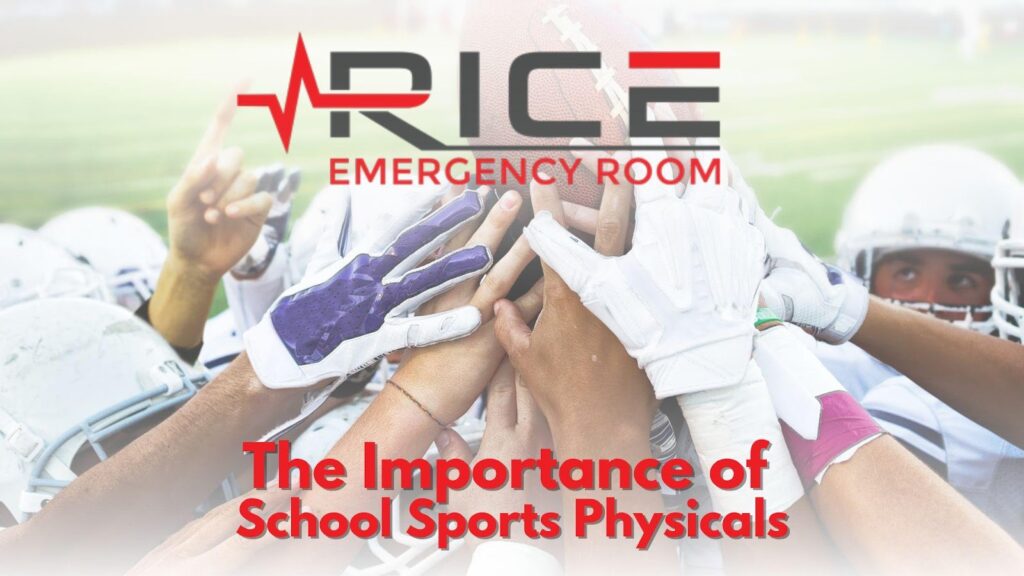As the school year begins, students at West University Elementary, West University Middle School, Lamar High School, and Rice University are gearing up for an exciting season of sports. Whether it’s the competitive intensity of football, the skill of baseball, the agility of volleyball, the speed of track, the endurance of swimming, or the precision of basketball, participating in sports plays a crucial role in a child’s development (American Academy of Pediatrics, 2020). To ensure these activities remain safe and enjoyable, it’s vital for parents to prioritize one key step: scheduling a school sports physical.
Preventing Serious Injuries Through Early Detection
A comprehensive sports physical is more than just a routine check; it’s a fundamental step in identifying potential health issues that could lead to serious pediatric injuries. These exams are designed to uncover any physical or biological abnormalities that might put young athletes at risk (Centers for Disease Control and Prevention, 2022). For example, conditions such as heart abnormalities, respiratory issues, or musculoskeletal problems can often go unnoticed without a thorough examination.
Football players are at risk for injuries like concussions, ligament tears, and fractures (National Football League, 2023). Baseball players might experience shoulder injuries or elbow strain from repetitive pitching (American Orthopaedic Society for Sports Medicine, 2021). Volleyball players can suffer from ankle sprains or knee injuries, while track athletes might face stress fractures or muscle strains (National Institute of Arthritis and Musculoskeletal and Skin Diseases, 2022). Swimmers, too, can experience shoulder pain or swimmer’s ear (American College of Sports Medicine, 2022). Basketball players are also at risk for injuries such as ankle sprains, knee injuries, and fractures from intense physical activity and frequent changes in direction (American Academy of Pediatrics, 2021). Identifying these risks early through a sports physical can help prevent them from developing into more serious issues.
Understanding the Role of School Sports Physicals
The primary goal of a sports physical is to ensure that a child is in good health and ready to participate in their chosen sport. This includes:
Medical History Review: The physician will ask about past injuries, existing medical conditions, and family health history to identify any pre-existing conditions that could impact athletic performance or safety (American College of Sports Medicine, 2022).
Physical Examination: This involves checking vital signs, evaluating cardiovascular and respiratory health, and assessing the musculoskeletal system to detect any potential issues that could lead to injuries (Centers for Disease Control and Prevention, 2022).
Fitness Assessment: The doctor may evaluate the child’s flexibility, strength, and overall physical fitness to ensure they are adequately prepared for their sport (American Academy of Pediatrics, 2020).
Advice and Recommendations: Based on the findings, the physician will provide recommendations for managing any identified issues and offer guidance on injury prevention strategies (American Orthopaedic Society for Sports Medicine, 2021).
The Role of Rice Emergency Room in School Sports Emergencies
In the event that an injury does occur, having a reliable medical facility ready to provide immediate care is essential. Rice Emergency Room in Rice Village is well-equipped to handle all school sports emergencies with expertise. With 24/7 radiology and on-site labs, they ensure prompt and accurate diagnosis of sports-related injuries (Rice Emergency Room, 2024).
Their advanced imaging and diagnostic capabilities allow for quick assessment of injuries, such as fractures or internal damage, while on-site labs enable immediate testing if needed (Rice Emergency Room, 2024). This level of comprehensive care ensures that athletes receive the necessary treatment without delay, facilitating a quicker recovery and a safe return to their sport.
Why It Matters
Prioritizing sports physicals helps not only in preventing injuries but also in fostering a culture of safety and health among young athletes. By taking these proactive measures, parents and guardians contribute to their child’s well-being and help them enjoy their sports activities with greater confidence and security (Centers for Disease Control and Prevention, 2022).
As the new sports season begins at West University Elementary, West University Middle School, Lamar High School, and Rice University, remember that your child’s safety is paramount. Schedule a sports physical to ensure they are ready for the season ahead with optimal health and reduced risk of injury.
For comprehensive sports injury care and emergencies, trust Rice Emergency Room in Rice Village. Their dedicated team is prepared to support you and your child every step of the way, ensuring that their athletic endeavors are as safe and enjoyable as possible.
Works Cited
American Academy of Pediatrics. (2020). Preparticipation Physical Evaluation. 5th ed. American Academy of Pediatrics.
American Academy of Pediatrics. (2021). Basketball Injuries in Young Athletes. American Academy of Pediatrics.
American College of Sports Medicine. (2022). ACSM’s Guidelines for Exercise Testing and Prescription. 11th ed. American College of Sports Medicine.
American Orthopaedic Society for Sports Medicine. (2021). Injury Prevention in Young Athletes. American Orthopaedic Society for Sports Medicine.
Centers for Disease Control and Prevention. (2022). Sports Physicals: What to Expect. Centers for Disease Control and Prevention.
National Football League. (2023). Football Injuries and Prevention. National Football League.
National Institute of Arthritis and Musculoskeletal and Skin Diseases. (2022). Exercise and Sports Injuries. National Institute of Arthritis and Musculoskeletal and Skin Diseases.
Rice Emergency Room. (2024). Emergency Services and Sports Injuries Care. Rice Emergency Room.




